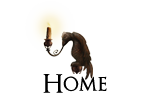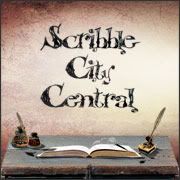I seem to have known about Candy Gourlay forever, but in fact I only met her "in the flesh" at the infamous "Ashcloud London Book Fair" this April. Now, I'm normally a law-abiding sort of person, but there must have been something in the air that day (other than ash), because I found myself becoming part of a guerilla author group which took over one of the empty stands. Candy was right in the middle of it all, taking photographs, organising us, ordering us about (she's small but pretty feisty). I took to her at once--nothing better than a feisty woman! Now her first novel for children, TALL STORY, which I have just finished reading, has just been published by David Fickling. I can tell you, it's really good and it's really different, and I love the way she has taken the Filipino myth of the giant Bernardo Carpio and woven it into her own present day story. I knew when I asked Candy to do this Mythic Interview that I had some gaps in my knowledge as far as Filipino myth was concerned. I didn't know just how big that gap was until I read her answers, and I can't wait to do some exploring to remedy that lack of knowledge. I really love the fact that Candy learnt the myths of her homeland via oral storytelling. It is a rare thing these days. If you've ever sat round a fire in the dark and swapped ghost stories, you will know how atmospheric and special it is, compared to reading from a book. Don't get me wrong--reading from a book is GREAT. But I have the clearest memories of an old man in our village who used to tell us tales about Hampshire and its folklore--what you should and shouldn't do in case of offending the fairies, forinstance. It was magical in the truest sense. I know you're going to love what Candy has to say here--and enjoy clicking on her links. Over to you, Candy, and thanks again for visiting Scribble City Central and sharing with us.
1. Do you think that the retelling of myths is important or relevant for the children of today? Why should they care about some “dry old stories” which come from ancient or forgotten cultures they might never even have heard of?
Oh yes – the retelling of myths is important. In every myth – whether it’s an ancient Greek story or a Filipino legend – we can hear the voices of storytellers from our long ago past.
Myths give a heartbeat to our culture, they tell us who we are and where we come from – we would be oh so much poorer if we forget them. Without these stories, we are incomplete.
2. What age were you when you came across your first myth or myths? Tell us how you felt then about the myths you first discovered. Did you love them or hate them? Did they scare you, excite you—or were you indifferent? What kind of myths were they? Greek? Norse? Native American? Celtic? Or from another culture entirely? Were they in a book you read? Or did you hear them as oral storytelling from someone else?
I learned about Greek and Norse mythology in school of course. But the mythology that informed my childhood was the mythology of the Philippines where I grew up. It is a mythology that reflects the geography of my country, which is one of several that straddle a split on the earth’s surface that has come to be known as the Ring of Fire – so called because volcanoes rise wherever the fissure lies. The Ring of Fire oozes calamity and our mythology reflects this.
There are few books about Philippine myths, so in the main they are learned as stories told by parents, grandparents and nannies. Much of the mythology is handed down orally – and so every storyteller gives each myth its own spin … and no one version is ever alike!
When I was a little girl, the electricity supply in Manila was constantly interrupted, and during the black-outs (or brown-outs, as we calle them in the Philippines) we would light candles and the adults would stop working and that’s when a lot of the stories got told.
I loved the stories – we didn’t have books read to us at bedtime as most children do here in England, so the candle-lit story telling sessions were a chance to bask in the total attention of our elders.
3. Looking back, what is your favourite myth of all time, from any culture? And why would you choose it?
One of my favourite Philippine myths was a creation myth set around the Callao Caves in Cagayan.
The caves are seven chambers set into a mountain. It is said that the gods used the Callao caves to create man and all living creatures. They shaped people out of mud and rain, popped them into the caves and baked them until done. I loved the idea of the gods baking away and populating the world!
4. Who is the mythical hero or heroine you most dislike, and what made you feel that way about them?
This is an impossible question. I tried thinking of villains in mythology but there is nothing I love more than a good baddy. So I couldn’t dislike any of the baddies. Sorry, I can’t think of a single one that I would dislike.
5. Is there a mythical beast you are particularly fond of? If so, which one?
In the Philippines, we have a marvellous monster called the Manananggal (literally the “disconnect” monster). She is a beautiful woman by day but at night, she sprouts huge leathery pterodactyl wings and her top half rips away from her bottom half. Some say she flies about preying on unfaithful young men. others say she finds pregnant women and using a straw, sucks the unborn child out. The only way to destroy her is to find her bottom half and sprinkle sea salt on the intestines that she has left behind. It’s gruesome and horrible and wonderful!
6. How have myths had an influence on your writing life, if at all?
When I started writing my book TALL STORY, I only wanted to write a story about a boy with gigantism. When I decided to set some of it in the Philippines, I remembered the stories my father used to tell me of Bernardo Carpio, a legendary giant.
I distinctly remember my Dad pointing out imprints on a mountain and telling me, “See, those are Bernardo Carpio’s foot prints!” Dad told me that when there were earthquakes (we have quite a few of those in the Philippines), it was just Bernardo Carpio, shrugging his shoulders.
I thought of using the Bernardo Carpio story. The boy, named Bernardo, in my story grows to eight feet tall and his village comes to believe that he is inhabited by the spirit of Bernardo Carpio. So sparks fly when Bernardo must move to England to join his mother who works in London as a nurse.
Philippine mythology is handed down in the oral tradition so every version of a story is different. In the years when the Philippines was a colony of Spain for example, Bernardo Carpio was portrayed as a revolutionary. So I look upon TALL STORY as my own telling.
I also used elements of Philippine creation mythology in both TALL STORY and an unpublished novel, VOLCANO CHILD. I hope this mythology which though part of my childhood is yet unheard of here in the West gives a fresh angle to my writing. I am also enormously proud to share some of my native culture in my books.
More about Candy:
Upon graduating from college in Manila, Candy was recruited to a magazine set up to oppose the regime of dictator Ferdinand Marcos. The magazine was instrumental to the fall of the Marcos dictatorship in 1986. It was in the midst of the so-called People Power revolution, that she met her husband, who at the time was the FT correspondent. When they moved to England in 1989, she found herself writing about over-the-counter drugs, media-buying, and toilet paper for a marketing magazine, before moving to the news agency Inter Press Service, for which she reported on first world issues from a developing world perspective. She went on to report widely on the Filipino migration phenomenon for various publications. In 2005, she returned to the Philippines to write and present the Radio 4 documentary, MOTHERLESS NATION, about the children left behind by migrant workers. Though her ambition since childhood has been to write fiction for children, she only began to pursue this dream in earnest after her own children were out of nappies. Her stories have appeared in anthologies as well as on the preschool BBC Radio channel, Cbeebies. TALL STORY is her debut novel, out in June.
Tall Story has a website www.tallstory.net. Candy blogs on Notes from the Slushpile, about writing, getting published, surviving the internet and never ever forgetting that some things we just do for love. Her author site is www.candygourlay.com and she tweets as candygourlay
Visit TALL STORY's Facebook page:
Subscribe to:
Post Comments (Atom)

















8 comments:
Great interview, Lucy and Candy. I loved Tall Story and I hope Filipino mythology reappears in Candy's next books.
Thank goodness for another foreigner (!) who knows myths other than the Greek ones...
thanks for this lucy! you've got a great blog!
A really fascinating interview! Thanks Lucy and Candy!
Wonderful interview, Lucy and Candy - like Keren, I'm hoping more Filipino mythology appears in more of Candy's books! (Candy, you may be onto something here! ;-) )
Wonderful! I want to know more, more, more about Philippine stories - look forward to reading Tall Story, Candy.
Thanks for all your comments--now, like Nicky, I'm just hoping that Candy's next book will have more Filipino myths in it. Go on, Candy, say you'll think about it! Bookwitch--see! I told you you weren't alone....
oh yes! the pitch for my work in progress is 'filipino monster in london' ... watch this space!
Post a Comment